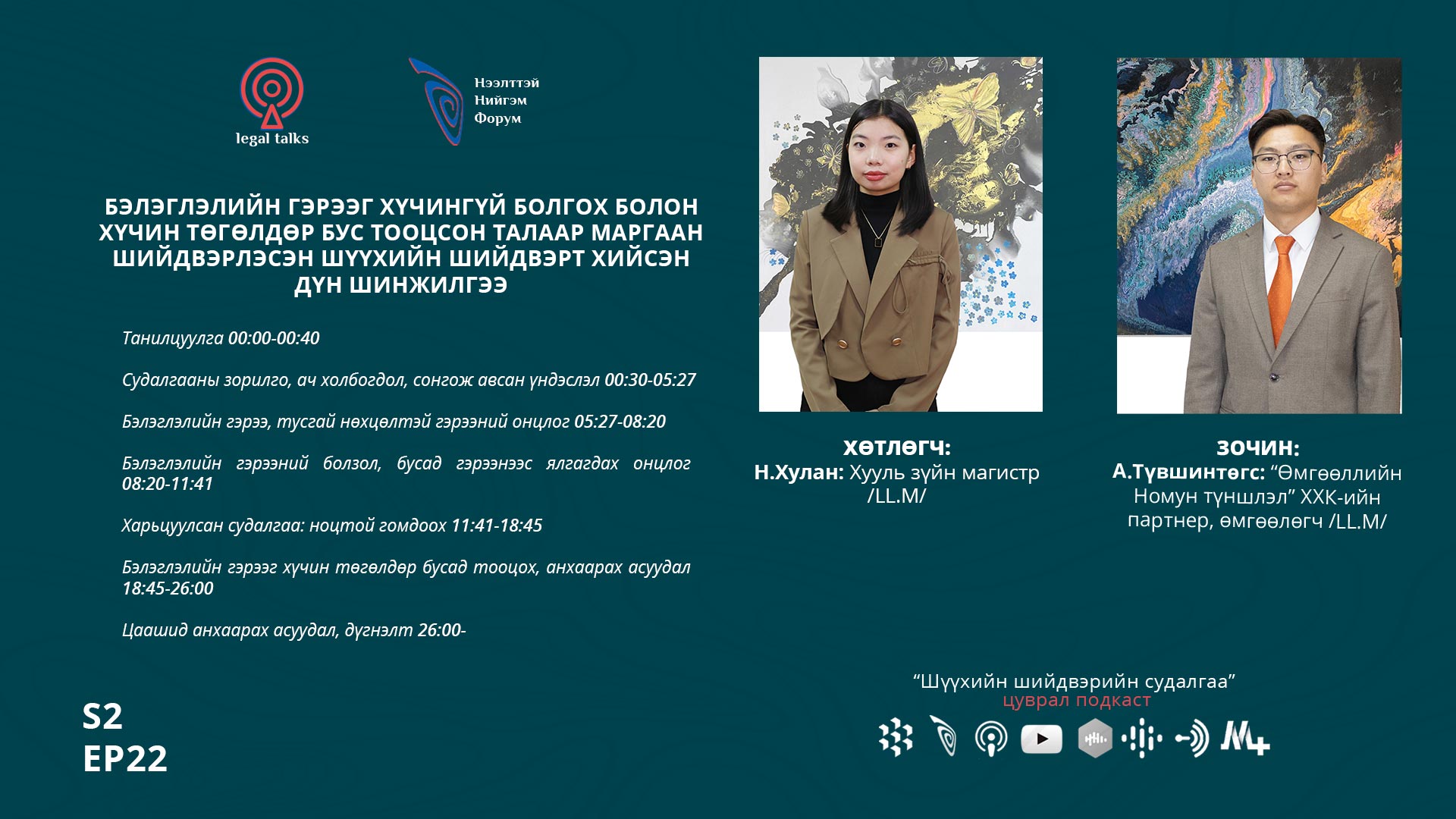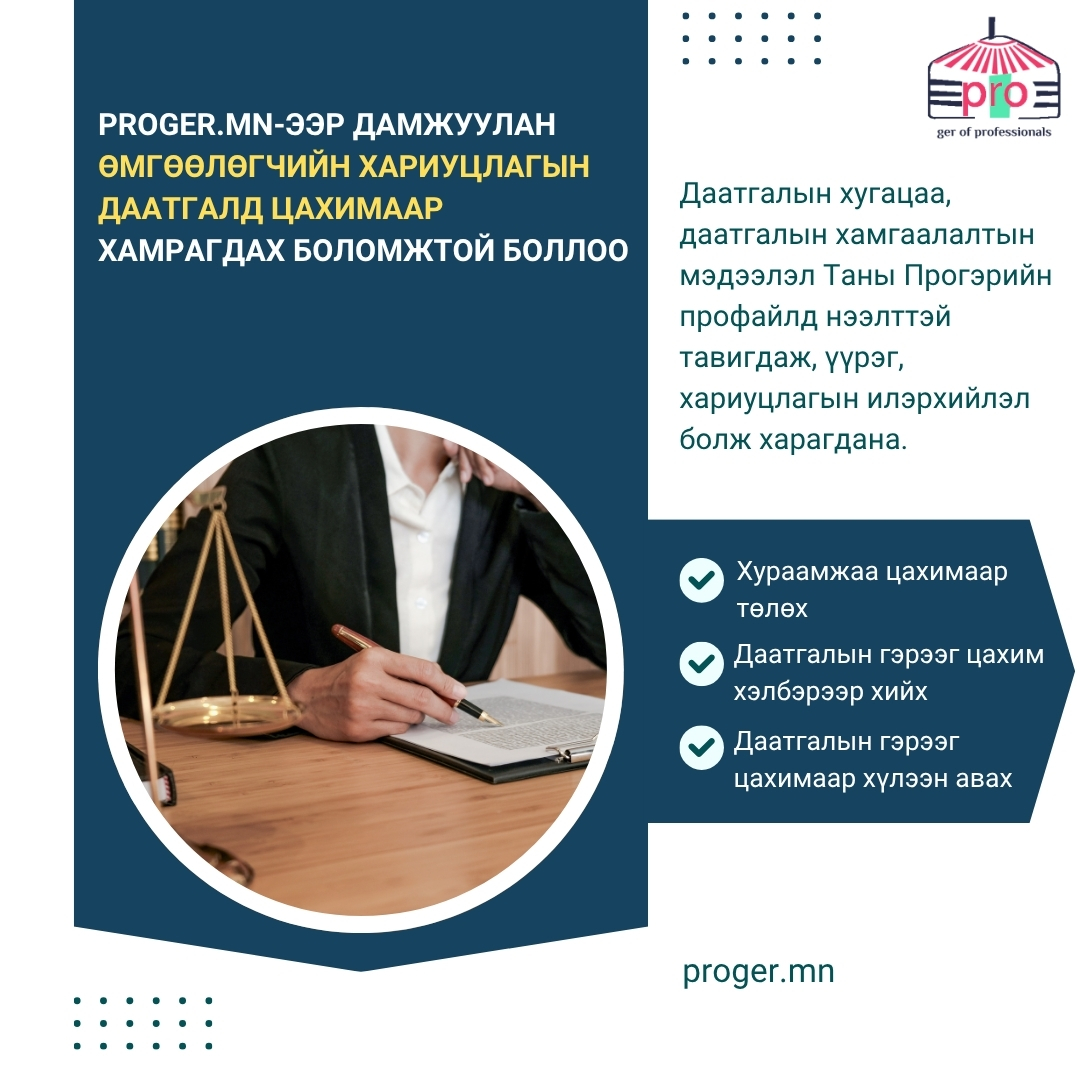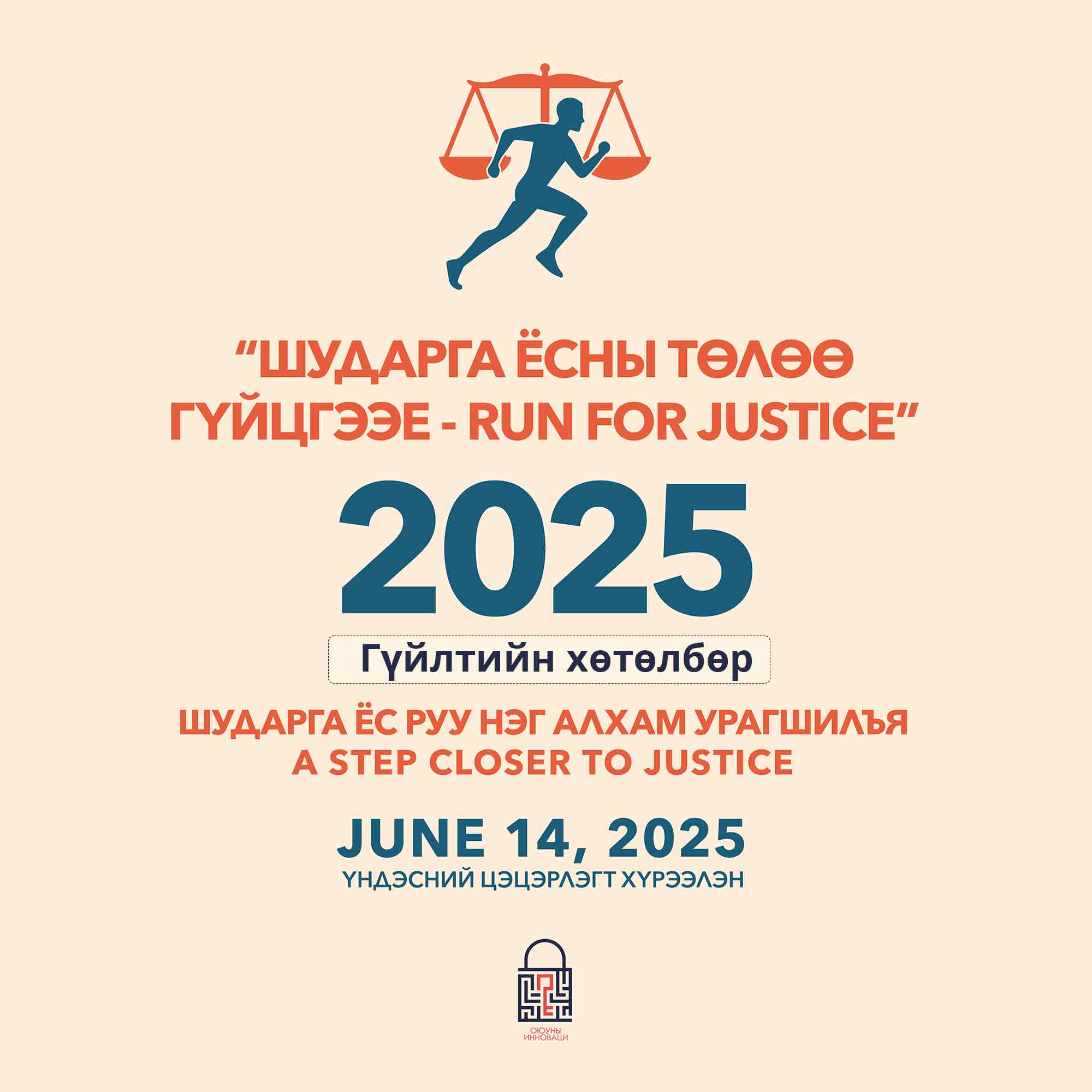Судалгааны ажилд онцдлон хэрэглэсэн "нэгдмэл суурь" гэх ойлголтыг газар ба түүний дээрх үл хөдлөх эд хөрөнгийн нэгдмэл хандлага гэх агуулгаар бус, харин төрийн ба хувийн өмчийн эрх зүйн газрын харилцааны суурь асуудлыг нэгтгэх шаардлага байгааг илэрхийлэх агуулгаар хэрэглэсэн болно.
This research examined development of the real property law of Mongolia in focusing on dilemmas emerged from in compliance between state property law and private property law, specifically, land related regimes in both areas. While the Land Law is a main legal resource for state land relations, the Civil Code contains basic and specific norms for private property relations at same time. Types of land rights that created on the state land are formulated by the Land Law as a direct reflection of wordings in the Constitution, while the property rights in the Civil Code are formulated based on the theoretical concepts of the Germanic legal family. As it originally purported to be, the property rights in the Civil Code protect activities, and are directed towards recognized ends, whereas terminologies and content of land rights over state land, creation of the state land right recording system, lack of a theoretical approach to land right transfer or termination and consequences are the main failures of the Land Law.
Regardless of its flaws the Land Law is a main resource provided handful rules for land relation in Mongolia, on the other hand, the real property rights in the private property law have not been an optimal for this society because of the insufficient scale of privately-owned land, the constitutional approach to limit private land ownership, and the legal interpretation encouraging the tendency of viewing the land as a public property. The basic principle of the real property law to foster private property is a concise reflection of a liberal concept of the Constitution of Mongolia. Yet, in addition to state dominancy of land ownership, stagnancy in development of state property law which doesn’t recognize basic principles in real property transfer such as superficies solo cedit, a principle of publicity and a formal approach to real property transactions, has been fading a significance of protection provided by the private property law of Mongolia. The main findings of the research can be summarized in the notion that regardless of an ownership type, urban land development requires different legal treatment from rural land, being provided with equal protection for land related rights in both areas created on the private and state-owned land along with the crystal-clear restrictive rules by public law. Lack of a unified foundation for development of state and private land relation produced serious problems in real property market in Mongolia.
From a structural point of view, the thesis examines parallel regimes for public and private land from historical, comparative and typological perspectives in each six chapters, not including the introduction and the conclusion parts. The thesis performed its first task to identify the problems underlined parallel regimes for real properties of Mongolia by means of analyzing respective provisions in the Constitution and implementation of a land reform and a detailed examination on the most relevant two laws of the Land Law and the Civil Code by its initial three chapters. Next three chapters served for a general task to find a solution and suggesting alternatives on the basis of findings from comparative study on the selected jurisdictions’ real property law and a uniqueness of Mongolia.
The thesis is the first work on the country level for considering the real property rights both in private and state land relation focusing on urban areas under the application of basic principles of property law. The previous works implemented by the local experts in property law area can be divided into two general sections as some focused on the specific categories such as the concepts of possession or hypothec individually from a private law perspective, while others concentrated on land as an administrative and an environmental law aspect such as land management or as being scarce natural resource. Therefore, outcomes of the current research are significant to look at entire framework of the real property regime established so far under the new Constitution and may contribute to rebuild successful land reform in urban areas.
Бүртгэлтэй бол нэвтрэх | Бүртгэлгүй бол бүртгүүлэх
N. Otgonchimeg, “Historical Comparison of Land Related Legislation of Mongolia,” Land, Management and Law Collection of Conference Papers, 2005, 81–102;
G. Saishaal, Chingis Khaanii Tovchoon, (Khukh hot, 1989). Н.Отгончимэг, Монгол Улсын газрын хууль тогтоомжийн түүхчилсэн харьцуулалт, Газар, Удирдлага, Эрх зүй эмхтгэл, Улаанбаатар, 2005, Г.Сайшаал, Чингис Хааны Товчоон.
V. A. Ryazanovskii, Great Rule of Chingis Khaan, Великая Яса Чингис Хана., 1933, 66.
Davharbayar Tsedevsuren, The Possession in Property Law and Its Protection Issues, PhD Diss, Ulaanbaatar, 2018), (last accessed April 16, 2021), available at: http://data.stf.mn/Scientist/ProfileViewPublic.aspx?id=1098956. Цэвээнсүрэнгийн Давхарбаяр, Эд юмсын эрх зүй дэх эзэмшил, түүний хамгаалалтын тулгамдсан асуудал сэдэвт докторын диссертаци.
Yanjinkhorloo Dambadarjaa, Pledge over Immovable Property (Hypothec) and Its Contemporary Issues, (PhD Diss, Ulaanbaatar, 2016), (last accessed April 16, 2021), available at: http://data.stf.mn/Publication/Thesis/ThesisViewPublic.aspx?id=128997. Дамбадаржаагийн Янжинхорлоо, Үл хөдлөх эд хөрөнгийн барьцааны эрх зүйн зохицуулалтын тулгамдсан асуудал сэдэвт докторын диссертаци.
N. Lundendorj, “Historical Debate on the Existence of Private Ownership of Land in Mongolia and Philosophical, Historical and Legal Analyses, Н. Лүндэндорж, Монголд Газрыг Хувьд Өмчлүүлж Байсан Эсэх Талаарх Түүхэн Маргаан, Түүнд Хийсэн Түүх, Философи, Эрх Зүйн Шинжилгээ, Газар, Удирдлага, Эрх Зүй Эмхтгэл.,” Land, Management and Law, Collection of the Conference Papers, 2005, 56–80.
Ch. Dalai, The Great Mongol Empire (1206-1260), Ч.Далай, Их Монгол Улс (1206-1260), vol. 2nd, n.d., 34–35.
S. Jalan-Aajav, The Khakh Juram Is the Ancient Legal Resource of Mongolia, С.Жалан-Аажав, Халх Журам Бол Монголын Хууль Цаазын Эртний Дурсгалт Бичиг. (Ulaanbaatar, 1958), 84–85.
E. A. Suhanov, Grajdanskoye Pravo, (2008), Е. А. Суханов, Гражданское Право, (Project of Institution of Economy and Law eBook, 2008), chap. 4, available at https://be5.biz/pravo/g016/index.html, last accessed April 19, 2021.
The State Great Khural, Minutes of IX Special Session of the State Great Khural, Улсын Их Хурлын Хэлэлцүүлгийн 9-р Тэмдэглэл, vol. 35, May 24, 1996, 16.
Munkhsaikhan, “Concepts of Amendments to the Constitution: Principles to Exploit Subsoil Wealth, О. Мөнхсайхан, Үндсэн Хуульд Оруулсан Нэмэлт, Өөрчлөлтийн Үзэл Баримтлал: Газрын Хэвлийн Баялаг Ашиглахад Баримтлах Зарчмууд.,” Law 3 (2020): 1–37.
S.Nyamzagd, Thoughts on State of Mongolia: One Important Issue: People’s Right, October 20, 1991, №88 (260). С. Нямзагд, Монгол төрийн ухааны нэгэн чухал асуудал, Ардын эрх сонин.
Sjef Van Erp, Comparative Property Law, in The Oxford Handbook of Comparative Law, 1054 (2006).
National Reports on the Transfers of Movables in Europe Volume 3: Germany, Greece, Lithuana, Hungary, 14 (Wolfgang Faber, & Brigitta Lurger eds., 2011).
Sh. Batsukh, “Current Situation and Further Development of the Land Reform of Mongolia, Монгол Улсын Газрын Харилцааны Шинэтгэлийн Өнөөгийн Байдал, Цаашдын Чиг Хандлага,” (Land, Management and Law, Ulaanbaatar, 2005), 5–14.
D.Lhamjav vs State Great Khural, (The Constitutional Court March 09, 1995). available at https://www.legalinfo.mn/law/details/1015?lawid=1015 (last accessed in April 2021). Үндсэн хуулийн цэцийн 3 дугаар дүгнэлт, 1995 оны 03 дугаар сарын 09-ний өдөр.
Chimid Byaraa, Concept of the Constitution, Бяраагийн Чимид, Үндсэн Хуулийн Үзэл Баримтлал., 2nd ed. (Ulaanbaatar, 2017), 37.
Deininger Klaus, and Feder Gershon, “Land Registration, Governance, and Development: Evidence and Implications for Policy.,” World Bank Research Observer. 24 (2009): 235, available at: 10.1093/wbro/lkp007.
Leonid Limonov, “Land Reform and Property Markets in Russia,” Land Lines, no. second quarter (April 2002), available at: https://www.lincolninst.edu/publications/articles/land-reform-property-markets-russia.
Christoph U. Schmid & Christian Hertel, Real Property Law and Procedure in the European Union, General Report (European University Institute (EUI); Florence/European Private Law Forum; Deutsches Notarinstitut (DNotI) Würzburg, 19 (May 31, 2005).
Priidu Parna, “Development of Apartment Ownership Legislation in Estonia in 1994-2009 and Reform Plans in the Context of European Judicial Practice,” Juridica International 16 (2009): 106.
Sjef Van Erp’s view is that the civilian tradition has two approaches to limited rights: first internal cumulative, in other words an”elastic concept of ownership”, and second external cumulative. For further detail: Comparative Property Law, in The Oxford Handbook of Comparative Law , 1057 (2006).
A. N. Yiannopoulos, Extinction of Predial Servitudes, 56 Tulane Law Review 1285–1316 (1981–1982).
Priidu Parna, The Law property Act-Cornerstone of the Civil Law Reform, 6, Juridica International 89–101, 96 (2001).
World Bank, Land Administration and Management in Ulaanbaatar, Mongolia, available at https://www.worldbank.org/en/country/mongolia/publication/land-administration-and-management-in-ulaanbaatar-mongolia (last visited Dec 10, 2020).
Espen Sgaastad, Daniel W. Bromley, (2000) The Prejudices of Property Rights: On Individualism, Specificity, and Security in Property Regimes., Vol 18. Issue (4). Development Policy Review, 89.
Deininger Klaus, and Feder Gershon, “Land Registration, Governance, and Development: Evidence and Implications for Policy.,” 235. (last accessed April 19, 2021),
Stephan Haggard, Institutions and growth in East Asia, 38 Stud. Comp. Int. Dev. 53–81 (2004);
Christian Hertel and Hartmut Wicke, Real Property Law and Procedure in the European Union: Germany, National Report, (2005), 5.
Rainer Frank, Privatization in Eastern Germany: A Comprehensive Study, Vanderbilt Journal of Transnational Law 27, no. 4 (1994): 811.
The Unification Treaty between the FRG and the GDR (Berlin, 31 August 1990), n.d., 29. Available at, https://www.cvce.eu/content/publication/1997/10/13/2c391661-db4e-42e5-84f7-bd86108c0b9c/publishable_en.pdf (accessed November 2020)
Ernst H. Feilchenfeld, Germanic Law and the German Civil Code, China Law Review 5, no. 2 (1932): 95.
Brehm, Wolfgang/Berger, Christian, Sachenrecht, 2nd ed. (Tubingen, 2006), no 1.38.
Brehm, Wolfgang/Berger, Christian, Sachenrecht (2nd ed. 2006) no 5.2.
Wolfgang Faber, Brigitta Lurger, National Reports on the Transfers on Movables in Europe Volume 1: Austria, Estonia, Italy, Slovenia (European law publishers, 2008), 233.
Shusei Ono, Comparative Study of the Transfer of Property Rights in Japanese Civil Law, Hitotsubashi Journal of Law and Politics 31 (2003): 9.
James Gordley and Ugo Mattei, “Protecting Possession,” American Journal of Comparative Law 44, no. 2 (1996): 295.
J.Gordley, Foundations of Private Law: Property, Tort, Contract, Unjust Enrichment, n.d., 55.
William Warwick Buckland, A Textbook of Roman Law from Augustus to Justinian, 2nd ed., 1932, 199.
Gordley and Mattei, “Protecting Possession,” 298.
R. Jhering, Uber Den Grund Des Besitzschutzes Eine Revision Der Lehre Vom, 2nd ed., 1869, 55.
Chung Han Kim, “Real Actions in Korea and Japan,” Tulane Law Review 29, no. 4 (1955 1954): 713.
Muller, K., Sachenrecht (Cologne, Germany: Carl Heymanns Verlag, 1988), 15. Grundstuck is in the BGB, section 1031, translated as “a plot of land”, translated by Paash in Classification of real property rights, p 25.
Jesper Paasch, “Classification of Real Property Rights : A Comparative Study of Real Property Rights in Germany, Ireland, the Netherlands and Sweden,” January 1, 2011, 27.
Jesper Paasch, “Classification of Real Property Rights: A Comparative Study of Real Property Rights in Germany, Ireland, the Netherlands and Sweden,” January 1, 2011, 28.
Barbara Pierre, “Classification of Property and Conceptions of Ownership in Civil and Common Law,” Revue Générale de Droit 28, no. 2 (March 16, 2016): 251, https://doi.org/10.7202/1035639ar.
Schmid and Hertel, “Real Property Law and Procedure in the European Union,” 19–21.
Norton Rose Fulbright, A Guide to Commercial and Residential Property Investment in Germany, n.d, 9.
Frank Bennett, Japanese Land Leases Revisited Old Tokyo Wine in a New Chicago Bottle, (2019), 1. Received a draft article via email communication with professor Frank Bennett, 2019.
Frank G. Jr. Bennett, Building Ownership in Modern Japanese Law: Origins of the Immobile Home, Law in Japan 26 (2000): 78.
Andre Sorensen, Land, Property Rights, and Planning in Japan: Institutional Design and Institutional Change in Land Management, Planning Perspectives 25 (July 1, 2010): 282, available at https://doi.org/10.1080/02665433.2010.481178. (last accessed January 2021)
James I. Nakamura, “Meiji Land Reform, Redistribution of Income, and Saving from Agriculture,” Economic Development and Cultural Change 14, no. 4 (1966): 429.
Shusei Ono, Comparative Study of the Transfer of Property Rights in Japanese Civil Law, Hitotsubashi Journal of Law and Politics 31 (2003): 3.
Kazuo Hatoyama, Civil Code of Japan Compared with the French Civil Code, Yale Law Journal 11, no. 7 (1902 1901): 364.
Hatoyama, “Civil Code of Japan Compared with the French Civil Code,” 360.
Kazuo Hatoyama, Civil Code of Japan Compared with the French Civil Code, Yale Law Journal 11, no. 7 (1902 1901): 362.
Kuniki Kamano, Condominium Legal System in Japan and Current Movement, 32 (n.d.): 123.
Kuniki Kamano, Condominium Legal System in Japan and Current Movement 32 (n.d.): 125.
Frank Bennett, Japanese Land Leases Revisited Old Tokyo Wine in a New Chicago Bottle, 2019, 6.
J. E. De Becker, Principles and Practice of the Civil Code of Japan, 1921, 202.
John Gadsby, Foreigners’ Right of Ownership to Land in Japan, Southern Bench and Bar Review 1, no. 6 (1913): 412.
Walter R. Iwaskiw, ed., Estonia, Latvia and Lithuana: A Country Study, (1996), 55. Available at https://www.loc.gov/item/96004057/, (accessed November 2020)
Miljan and Toivo, Historical Dictionary of Estonia, (Rowman & Littlefield, 2015), 18–19.
Maapaev was the provisional assembly of the Country. During collapse of tsarist regime by February 1917 large number of Estonian populations forced the provisional government to accept Estonia’s territorial unification as a one province and the election of provisional assembly Maapaev.
Paul Varul, Creation of New Private Law in Estonia, 31, Rechtsetheorie, (2002), 349-367.
Siim Maasikamäe and Evelin Jürgenson, Main Principles of the Formation of State Land Reserve in Estonia, n.d., 1, available at http://www.fao.org/fileadmin/user_upload/reu/europe/documents/LANDNET/2008/Estonia_Paper.pdf. (Last visited in September 2020), 2.
Karin Visnapuu, “Land Reform and the Principle of Legal Certainty: The Practice of the Supreme Court of Estonia in 1918–1933,” Juridica International 27 (September 30, 2018): 53–60, available at https://doi.org/10.12697/JI.2018.27.05, (last accessed in October 2020).
W.Roszkowski, Land Reforms in East Central Europe after World War One. Polish Academy of Sciences Institute of Political Studies, (1995).
Mark B. Lapping, “The Land Reform in Independent Estonia: Memory as Precedent — Toward the Reconstruction of Agriculture in Eastern Europe,” Agriculture and Human Values 10, no. 1 (December 1, 1993): 52–59, available at https://doi.org/10.1007/BF02217730, last accessed in October 2020.
Saint-Petersburg State University et al., “Land Use Policy and Land Management in Estonia,” Baltic Region 9, no. 1 (March 29, 2017): 91–104, available at https://doi.org/10.5922/2079-8555-2017-1-8 (last accessed in October 2020).
Priidu Parna, “Legal Reform in Estonia,” International Journal of Legal Information 33(2) (2005): 219–23.
Siim Maasikamäe and Evelin Jürgenson, Main Principles of the Formation of State Land Reserve in Estonia, n.d., 1, available at http://www.fao.org/fileadmin/user_upload/reu/europe/documents/LANDNET/2008/Estonia_Paper.pdf. (Last visited in September 2020).
Priidu Parna, The Law Property Act-Cornerstone of the Civil Law Reform, Juridica International 6 (2001), 91.
Wolfgang Faber, Brigitta Lurger, National Reports on the Transfers on Movables in Europe Volume 1: Austria, Estonia, Italy, Slovenia, 228.
European Land Registry Association, Publication on Encumbrances of the Republic of Estonia, available at: https://www.elra.eu/contact-point-contribution/estonia/encumbrances-section-c-7/. (last accessed in November 2020.)
Saint-Petersburg State University et al., Land Use Policy and Land Management in Estonia, Baltic Region 9, no. 1 (March 29, 2017): 93, available at https://doi.org/10.5922/2079-8555-2017-1-8. (last accessed in November 2020)
United Nations, Juan Pablo Bohoslavsky, Report of the Independent Expert on the Effects of Foreign Debt and Other Related International Financial Obligations of States on the Full Enjoyment of All Human Rights, Particularly Economic, Social and Cultural Rights, on His Visit to Mongolia, n.d., 7, available at: https://www.undocs.org/A/HRC/43/45/Add.2. (accessed February 2021)
World bank, Mongolia’s 2018 Poverty Rate Estimated at 28.4 percent, accessed March 22, 2021, available at: https://www.worldbank.org/en/news/press-release/2019/06/21/mongolias-2018-poverty-rate-estimated-at-284-percent.
Mongolia’s 2018 Poverty Rate Estimated at 28.4 percent.
National Statistics Committee, “Summary of the Aggregate Annual Estimation of Population and Dwellings in Capital City of 2020. Үндэсний Статистикийн Хороо, Хүн Ам, Орон Сууцны 2020 Оны Улсын Ээлжит Тооллогын Нийслэлийн Нэгдсэн Дүн.,” n.d., 18, available at. https://www.1212.mn/BookLibraryDownload.ashx?url=1.Summary%20report_Ulaanbaatar.pdf&ln=Mn,(accessed February 2021), .
Independent Authority Against Corruption of Mongolia, “Assessment of Fairness-2018, p.18, n.d., Авилгатай Тэмцэх Газар, Шударга Байдлын Үнэлгээ-2018.,” n.d., (last accessed in February 2021), https://www.iaac.mn/news/shudarga-baidliin-unelgee-2sh18-sudalgaanii-tailan?menu=181.
Government Agency for Land Administration and Management, Geodesy, Cartography, “Unified Annual Report on Land Fund 2018, Газрын нэгдмэл сангийн тайлан 2018 он” (Ulaanbaatar, 2019), 46, https://www.gazar.gov.mn/report/gnst/gazryn-negdmel-sangijn-tajlan-2018-on.
National Statistical Committee, “Report on Income of Unified Budget of Mongolia, Үндэсний Статистикийн Хороо, Монгол Улсын Нэгдсэн Төсвийн Орлого,” 409, accessed March 28, 2021, https://www.1212.mn/tables.aspx?tbl_id=dt_nso_0800_002v1&13999001_select_all=0&13999001singleselect=&tt1_select_all=0&tt1singleselect=_1020101_102010103&yearm_select_all=0&yearmsingleselect=_202011_202010_202009_202008_202007_202006_202005_202004_202003_202002_202001_202012&viewtype=table.
National Statistical Committee, “General Report on Budget 2018, Үндэсний Статистикийн Хороо, 2018 Оны Төсвийн Тайлан.,” accessed March 28, 2021, https://1212.mn/Stat.aspx?LIST_ID=976_L08.
Masao Osawa, Japanese Consciousness of Land Ownership: A Questionnaire and Comments, Law in Japan 20 (1987): 147.
МЭДЭЭ, МЭДЭЭЛЭЛ

S2EP22. А.Түвшинтөгс: Бэлэглэлийн гэрээг хүчингүй болгох болон хүчин төгөлдөр бус тооцсон талаар маргаан шийдвэрлэсэн шүүхийн шийдвэрт хийсэн дүн шинжилгээ
4 hours ago

Өмгөөлөгч мэргэжлийн хариуцлагын даатгалдаа цахимаар хамрагдах боломжтой боллоо
1 week ago

“Шударга ёсны төлөө гүйцгээе – Run for Justice” олон нийтийн гүйлтийн арга хэмжээ болно
1 week ago

S2EP21. М.Маралмаа & Р.Оюундэлгэр: Хяналтын журмаар гаргах гомдолд үндэслэл тогтоох зохицуулалтын хэрэглээ
1 week ago
-
Ганбат Мөнхтулга
2025-06-26 Эрдэм шинжилгээний өгүүлэлдуудаж байна ! -
Батсайханы Мөнхзул
2025-06-26 Эрдэм шинжилгээний өгүүлэлдуудаж байна ! -
Ганбат Мөнхтулга
2025-06-25 Эрдэм шинжилгээний өгүүлэлдуудаж байна ! -
Баатарын Сарантуяа
2025-06-24 Эрдэм шинжилгээний өгүүлэлдуудаж байна ! -
Ганбат Мөнхтулга
2025-06-24 Эрдэм шинжилгээний өгүүлэлдуудаж байна ! -
Judilogy
2025-06-23 Мэдээллийн хуудасдуудаж байна ! -
Ганбат Мөнхтулга Нэрэндашийн Дуламсүрэн
2025-06-23 Эрдэм шинжилгээний өгүүлэлдуудаж байна ! -
Чинбатын Болормаа
2025-06-23 Эрдэм шинжилгээний өгүүлэлдуудаж байна ! -
Ганбат Мөнхтулга
2025-06-23 Эрдэм шинжилгээний өгүүлэлдуудаж байна ! -
Ганбат Мөнхтулга Мөнхгэрэлийн Дэлгэрмаа
2025-06-22 Эрдэм шинжилгээний өгүүлэлдуудаж байна !